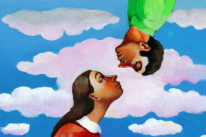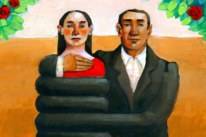
“There is such a deeply rooted belief that we must do something with intense surges of feeling and emotion as they wash through: understand them, determine their cause, link them to some life circumstance or person, transform them, transmute them, or even ‘heal’ them.” ~Matt Licata
A few years ago, when I first started working for my current organization, one of my colleagues asked me what role I would most enjoy on the team.
I quickly said, “I like making things happen.”
That was so clear to me—I’m a natural do-er, organizer, and planner. It’s easy for me to take action on manifesting things in the world.
While that has been useful for creating a sense of security in the material world, it has been less helpful for navigating the inner world.
My same orientation toward the outside world, I brought to my emotions and how I met other people’s feelings.
“You always try to fix the situation,” my husband said on the car ride home as grief was arising from visiting his ill mom. “Like, you know a process that works for you, and it feels as if you try to draft me into it.”
That was hard to hear. I was defensive at first, “What? No I’m not. I really care about you, and am trying to help you…”
As I sat with what he said and reflected on our conversation from a moment earlier, I realized that I was asking him over and over about how he was feeling, giving him suggestions and tools that have worked for me, that I thought might work for him too.
When I peeled back another layer of my intention, I recognized it was mostly out of my own angst—the discomfort of just sitting there with him in presence, listening, with uncertainty. This nagging feeling of “needing to know” and “needing to make better” kept tugging at me.
And so, finally, I gave in and asked several questions back to back that he was not yet ready to answer, followed by several uninvited suggestions.
Over the next day, I continued to reflect on how to be with others and found there was a lot for me to learn from this situation with my husband.
It’s true, when things are hard my mind perks up and goes into doing mode. I think, “What can I do? How do we make this better? What can be done to fix this situation and make it a bit more pleasant?”
Anything to not linger in uncertainty and the discomfort of “unresolved” emotion.
In that layer beneath the really good intention to help and make better, there is a more subtle motivation that says, “To stay with the vulnerability of this pain is really hard. It’s scary to be with the unknown. What can we do to make it go away and begin moving forward from this?”
To sit with difficult emotions and not try to fix or make something better has been a huge learning curve for me over the past years, especially with emotional pain—both for myself and with those who are closest to me.
Recently, when I see someone else in pain, I’ve been practicing “being with” and “witnessing,” and just deeply listening. It’s not an easy practice, as I’ve had thirty-three years of a conditioned, habitual impulse to “fix” and “move on” and “make better.”
And yet, I see that the longer that I can stay with difficult emotions (my own and others’), the more I experience moments of deep peace, held with compassion.
In fact, I often find that nothing needed fixing or to be “done.” Presence and being with is enough.
Here are three lessons I’ve learned on how to be with others when faced with difficult emotions:
1. Be with.
This has been my mantra for the past six months. In fact, I even wear a bracelet daily with that phrase engraved.
“Be with” reminds me to show up in a way that fully meets the present moment. Usually, that translates into deeply listening the best I can, remembering to breathe, coming back to the body, and not getting caught up in my mind.
It reminds me to witness and not go down that path of fixing and making better.
2. Do nothing.
“This ‘doing nothing’ is not a cold, passive resignation, but is an alive, sacred activity, infused with the light of awareness and a wild, relentless sort of compassion. To do nothing in this way is a radical act of kindness and love, filled with qualities of earth and warmth, and a holy gift that you can offer yourself and others.” ~Matt Licata
A friend of mine shared that when she was in psychology school, many of the therapists often asked, “But what I can I do to help my client?” Because doing nothing didn’t feel like enough.
Each time this question came up, the teacher would always say the same thing: “Just be with his/her process. As that’s the only thing that creates lasting change.”
There is a difference between powerlessness and helplessness. To surrender, which is to be powerlessness and to do nothing, does not equate to being helpless. When we are able to surrender and accept our powerlessness over others’ emotional pain and circumstance, we can wake up to deeper wisdom.
Simply being present for the other exactly as he/she is—doing nothing—can be the most loving, powerful gift.
3. Loving-kindness.
During the moments when being with or doing nothing is too challenging, a loving-kindness mantra has always been helpful for me. It can bring a momentary peace during difficult situations when the mind might otherwise run along with thinking, planning, or engaging in fear-based stories to distract from the present moment.
It goes like this: You say the below quietly inside, with an open heart.
“May I be safe. May I be free from fear. May I be free from suffering.“ And, “May you be safe. May you be free from fear. May you be free from suffering.”
What do you find helpful when those close to you are in emotional pain or in challenging situations? How do you meet yourself during difficult emotions?
About Cat Li Stevenson
Cat is an explorer of the human journey and a lover of well-being. She is living and practicing at an urban Zen Center in San Francisco, and working for Wisdom 2.0, an organization that strives to bring wisdom and awareness into the digital age. You can add her as a friend on FB or find her writing on Medium.













 Though I run this site, it is not mine. It's ours. It's not about me. It's about us. Your stories and your wisdom are just as meaningful as mine.
Though I run this site, it is not mine. It's ours. It's not about me. It's about us. Your stories and your wisdom are just as meaningful as mine. 